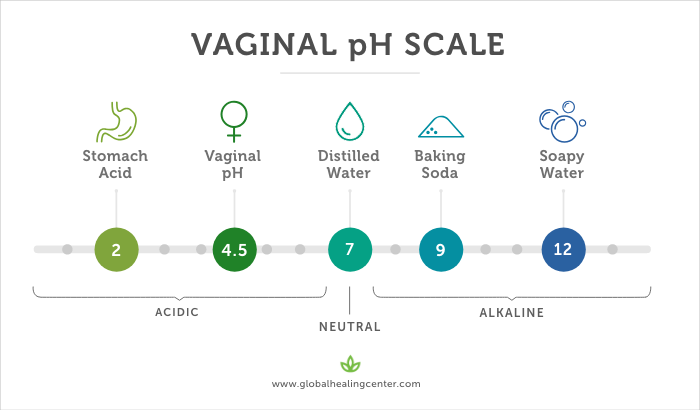
By Krishna Delvadiya PHT
What is pH?
pH is a measurement of how acidic or alkaline (basic) a substance is. The scale runs from 0 to 14. A pH of less than 7 is considered acidic, and a pH of more than 7 is basic.

What does any of this have to do with your vagina?
Every woman should be aware of the concept of vaginal pH. The pH level of your vagina — whether it’s acidic or basic — plays an important part in determining whether it’s healthy.

What is a normal vaginal pH?
A normal vaginal pH level is between 3.8 and 4.5, which is moderately acidic. However, what constitutes a “normal” pH level can vary slightly based on your stage of life.
For example, during your reproductive years (ages 15 to 49), your vaginal pH should be below or equal to 4.5. However, before menstruation and after menopause, a healthy pH tends to be higher than 4.5.
So why does vaginal pH matter?
An acidic vaginal environment is protective. It creates a barrier that prevents unhealthy bacteria and yeast from multiplying too quickly and causing infection.
A high vaginal pH level — above 4.5 — provides the perfect environment for unhealthy bacteria to grow. Having a high vaginal pH puts you at risk for these infections:
- Bacterial vaginosis (BV) is a bacterial overgrowth condition that causes a “fishy” odor, along with an unusual gray, white, or yellow vaginal discharge. It can also result in vaginal itchiness and burning during urination.
- Trichomoniasis (trich) is a sexually transmitted disease (STD) caused by the parasite Trichomonas vaginalis. Trich usually doesn’t cause symptoms in the majority of those infected, but it can increase your risk for other, more serious STDs, like HIV. An acidic vagina usually doesn’t cause disease. But if the acidity rises too much, it might reduce your fertility. Sperm thrive in an alkaline environment. The optimal pH for them to swim is between 7.0 and 8.5. During sex, the pH level inside the vagina temporarily rises, making the normally acidic environment more alkaline to protect the sperm so they can make their way to the egg.

What causes an unbalanced vaginal pH?
Any of the following situations can change your vaginal pH level:
- Unprotected sex. Semen is alkaline, which can encourage growth of certain bacteria.
- Antibiotics. These drugs kill not only the bad bacteria that cause disease, but also the good bacteria you need to maintain a healthy, more acidic vaginal pH level.
- Douching. Douching refers to washing or cleaning the vagina using particular solutions, such as those containing vinegar or baking soda. Douching not only increases the vaginal pH level, but also encourages the growth of harmful bacterial overall.
- Menstrual periods. Menstrual blood is a little bit basic and raises the pH in the vagina. When that blood flows through the vagina and is absorbed into a tampon or pad and sits in place, it can raise the pH level of the vagina.
Signs and symptoms of an unbalanced vaginal pH
A high pH level that leads to BV or another infection may cause symptoms like:
- A foul or fishy smell
- Unusual white, gray, or green discharge
- Vaginal itching
- Burning when you urinate
How should I test my vaginal pH?
A home Vaginal pH test kit typically includes a piece of pH test paper and a color chart for determining your vaginal pH results. To perform the test, follow the instructions are given in the test kit.
Next, compare the color of your pH test paper to the color chart. Whilst the color may not be an exact match to the chart, you should choose the color your test result closely resembles and determine the pH results according to instructions.
How to correct an imbalanced vaginal pH?
To keep the pH of your vagina at a consistently healthy level, you can consult your medical doctor and follow their prescriptions or suggestions in order to correct any imbalances.
So as you can see ladies, a healthy vaginal pH is essential to keeping your vaginal health in tip top shape.





